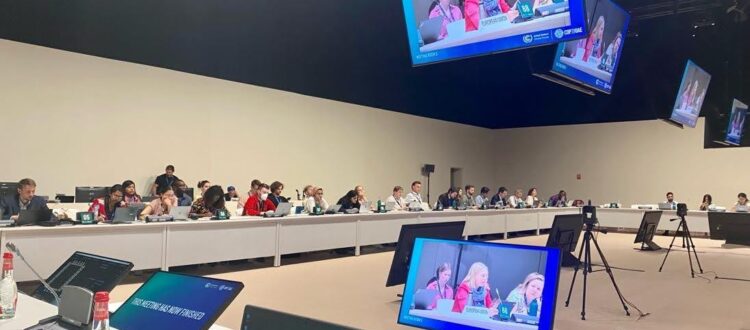CLIMATE FINANCE AND WHERE TO FIND IT
- In addition to the new post-2025 climate finance goal, the previous goal of $100 billion is also discussed at COP28.
- According to an OECD report, developed Countries have probably reached the sum in 2022, but the gap from previous years still remains.
- It is important to establish guidelines to define what is meant by “climate finance”.
- We must also identify the sources: public finance must be central, and there are solutions to increase it, but progress is slow.
In parallel to the new post-2025 climate finance objective (New Collective Quantified Goal), so-called “long-term finance” is also being discussed at COP28.
A bit of context: at COP15 in Copenhagen it was established that Annex II Countries, those with the obligation to provide financial support, would have to allocate a sum of 100 billion dollars a year by 2020. The goal was then extended until 2025, the year in which the new goal will come into force. Subsequently, COP17 in Durban created a work program to help developed Countries identifying sources to draw from and effective ways to mobilize the 100 billion. In this context, developed Countries were required to submit biennial reports on the strategies pursued to increase climate finance.
Currently, here at COP28 the discussions on climate finance mainly revolve around the “old” 100 billion goal and how to fill the gap that still persists to finally reach the entire sum.
In their speeches, developed Countries highlight the progress made: according to a report from the OECD (Organisation for Economic Co-operation and Development), the goal has probably been reached in 2022.
According to developing Countries, however, progress cannot make us forget the shortcomings accumulated in previous years and not yet compensated for: we are talking about 16.7 billion in 2020 and 10.4 billion in 2021, for a total of 27.1 billion.
Despite the focus on 100 billion by 2025, the good practices collected will also be used to set the new post-2025 goal so that it won’t have the same limits as the previous one.
In fact, even if the old goal is about to expire, the dialogue on long-term climate finance will continue until 2027 also in relation to the new goal: it is essential that, on the one hand, developed Countries continue to provide transparent and complete information on their financial support and, on the other hand, developing Countries receive support to concretely identify their needs.
The first fundamental step to provide effective financial support is to give a precise definition of “climate finance”. In fact, there are still no guidelines to define what can be considered climate finance within the UNFCCC, and this does not guarantee transparency in the reporting of Annex II Countries. In this regard, this lack of transparency has so far allowed the Annex II Countries to overestimate the actual sums allocated, counting in the total financing that was already part of other types of commitments (such as humanitarian development aid), and even the financing of absurd projects (from a coal-fired power plant to a romantic film set in the Argentine rainforest!).
Consequently, the issue of the defining climate finance finds a lot of space in current discussions, with developing Countries pushing to insert clear guidelines on which to base financial contributions, while developed Countries would obviously prefer to maintain the current ambiguity.
Another important issue is the sources to draw the fundings from: fortunately, developed Countries increasingly recognize the centrality of public funding. Indeed, private investments play an important role, but they are problematic in several aspects: in addition to aggravating the indebtedness of vulnerable Countries, they cause other negative impacts such as the privatization of basic services or an increase in inequalities, and often lack measures of protection of human rights.
Therefore, governments should instead favor solutions to increase public funding, and many of the existing solutions revolve around the principle of “making those responsible for the majority of emissions pay”. Among the solutions proposed by civil society are: a tax on the record profits of fossil fuel companies, the abandonment of fossil fuel subsidies, a tax on maxi-incomes (the richest 10% of the world’s population is responsible for 50% of emissions).
The possibility of implementing some of them is finally also discussed at a political level, as happened for example at the Paris Summit for the new global financial pact, which more generally concerned the transformation of the global financial system, a need that is now also recognized by the governments of the richest Countries.
However, concrete commitments to actually implement these solutions have not yet emerged. For example, the promise to abandon fossil subsidies dates back to the 2009 Pittsburgh G20 leaders’ declaration, but governments have never followed through on it, thanks to the inclusion of loopholes such as “inefficient subsidies” in the text.
Reversing the trend seems like no small feat: applying the principle of “make polluters pay” (as also requested by our Spark consortium with the European petition that we can sign), would mean completely rethinking our economic system, so that all financial flows are consistent with the objectives of the Paris Agreement.
Nonetheless, this is essential for finding funds to invest in the transition, especially in those Countries that most need resources and are most affected by the effects not only of climate change, but also of a profoundly unequal socioeconomic system. It is therefore first of all a question of fairness and justice.
But not only that: the alignment of financial flows is one of the three key commitments of the Agreement (along with the 1.5°C goal and adaptation), and efforts to respect it have already been postponed for too long.
Article by Teresa Giuffrè, delegate of the Italian Climate Network at COP28
Cover photo: Teresa Giuffrè

